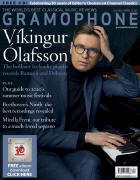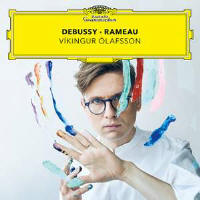Texte paru dans: / Appeared in: |
|
 |
Outil de traduction (Très approximatif) |
|
Reviewer: Harriet Smith After reviewing Vikingur Ólafsson’s disc of Bach (11/18) I was eager to hear what he’d do next and this certainly doesn’t disappoint. The disc is simply titled ‘Debussy Rameau’. It could have been a triumph of style over substance but, like the Bach, the programming here is truly inspired. Debussy was a big admirer of his French forebear, finding a ‘perfect taste and strict elegance which make up the consummate beauty of his music’. We begin with the beguiling Prélude from La damoiselle élue in Debussy’s own transcription, which sets the tone and immediately establishes the fineness of the instrument and the recording. Ólafsson groups the Rameau together very effectively: the first set, for instance, all from the 1724 Pièces de clavecin, begins with ‘Le rappel des oiseaux’ – full of energy without the accents becoming jabby, the sustaining pedal used judiciously – followed by the strutting dance of the ‘Rigaudon’, with wonderful interplay between the contrapuntal lines; the ‘Musette en rondeau’ then relaxes the mood, while in the ‘Tambourin’ he conjures the brilliance of the harpsichord’s sound world, giving the closing phrases a real grace (something of an Ólafsson trademark). ‘La Villageoise’ is full of character, the middle section becoming still more energised, while the ‘Gigue en rondeau’ is lovingly done – in a lesser artist the ornamentation could have sounded overstated, but not here. Placing Debussy’s ‘Jardins sous la pluie’ (Estampes) next makes you realise how much its composer learnt from the great toccata tradition, emphasised by the verve with which Ólafsson approaches it. What follows explores the same train of thought – from Children’s Corner the ‘Serenade for the Doll’ (though he’s less anarchic here than Steven Osborne – Hyperion, 10/17) and ‘The Snow is Dancing’, in which he effectively blurs the textures as the harmonies become more hazy. And so it continues, the two composers sounding very at home with one another. The highlights are many: the way the shadows of ‘Des pas sur la neige’, with its upward phrases, are dismissed by the cascading downward scales of ‘La Joyeuse’ from the 1724 Pièces de clavecin, a mood intensified by ‘Les Cyclopes’, built similarly on descending patterns but even more frenetic (the pianist’s complete control of dynamics and colours makes this a particular highlight). And he makes the most well-known pieces his own without caricature: ‘La poule’, its repeated chords effortlessly dispatched, or ‘Les sauvages’, which Ólafsson laces with ever more outlandish ornamentation. As a centrepiece he offers The Arts and the Hours, an interlude that he has arranged from Rameau’s last opera, Les Boréades, in which the octogenarian’s highly characteristic harmonic language gets ever more daring. Where else could Ólafsson end but with ‘Hommage à Rameau’ from Images, Book 1? It not only brings the two composers together but offers the perfect distillation of all that has gone before. |
|




